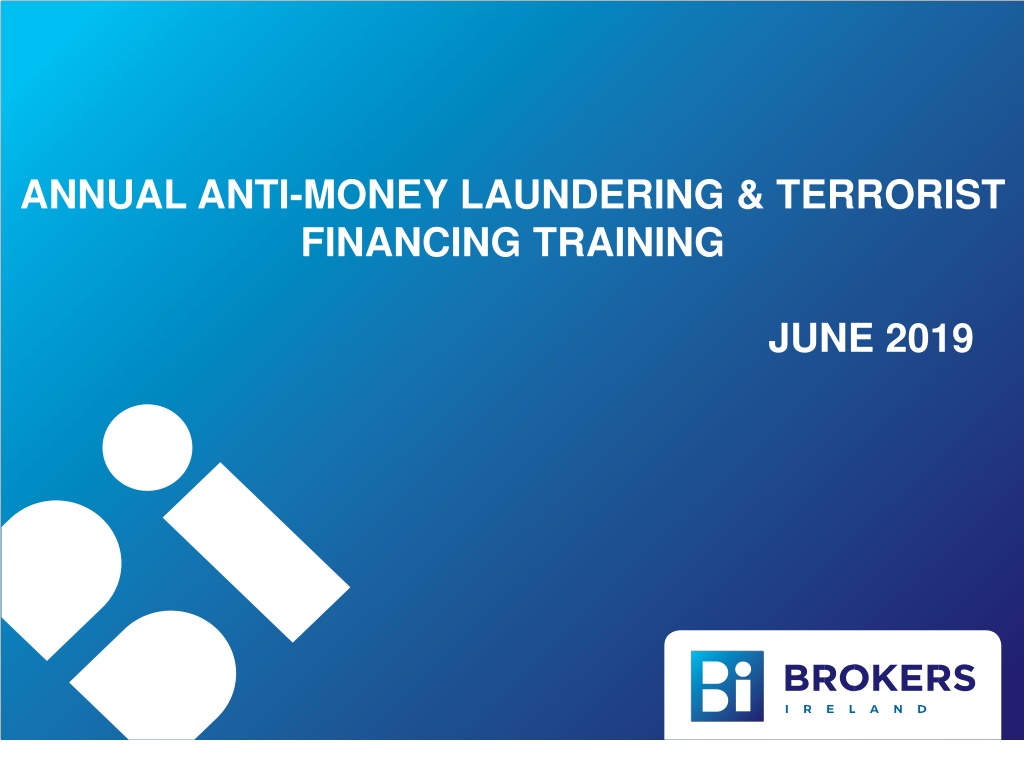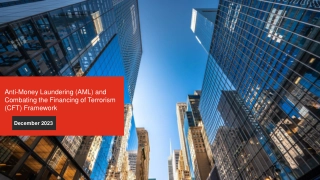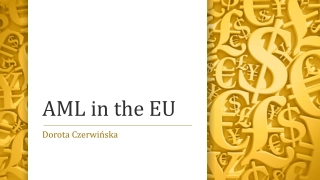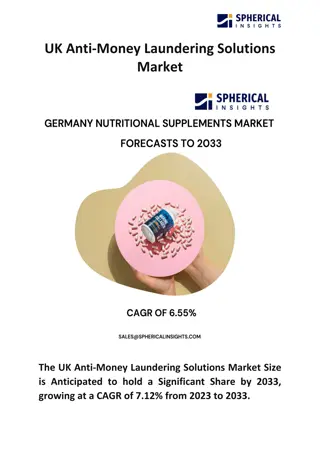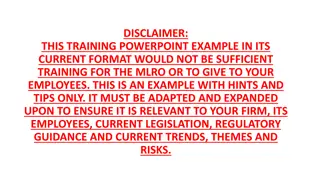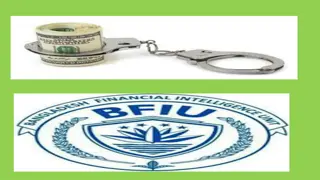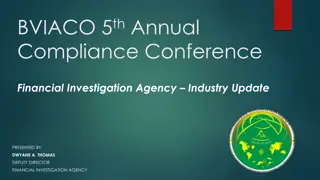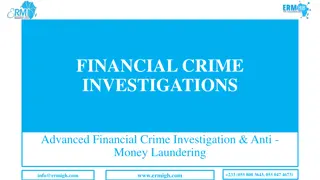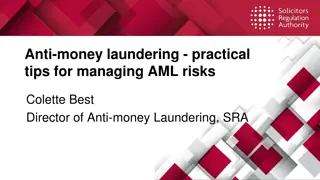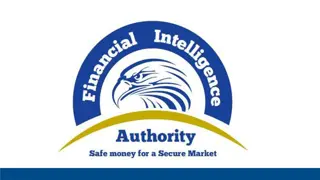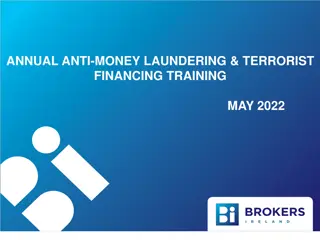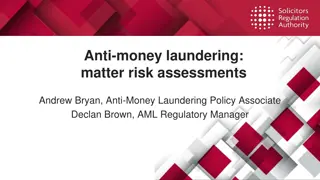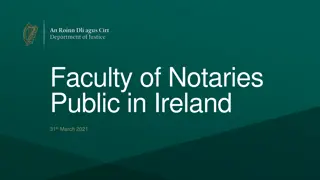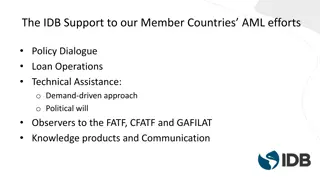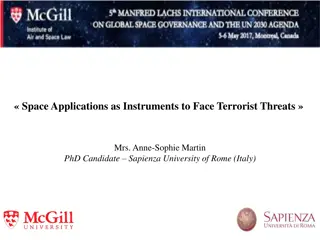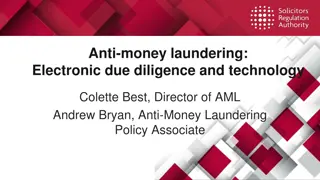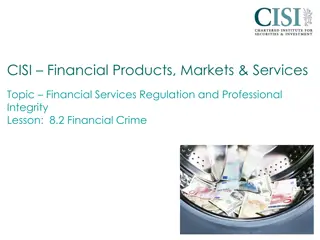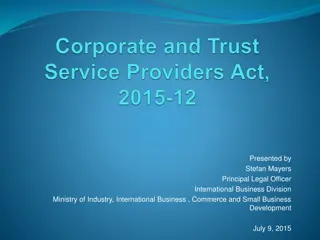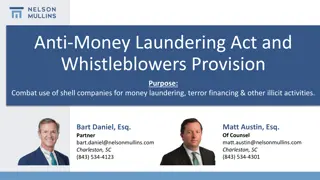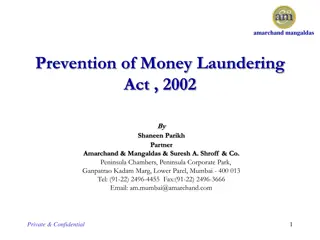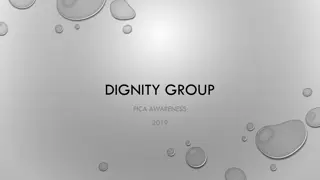Understanding Anti-Money Laundering and Terrorist Financing
Exploring the Irish AML/CTF legislative framework, definitions of money laundering and terrorist financing, elements of guilt, stages of money laundering, and the role of Designated Persons in combating financial crimes.
Download Presentation

Please find below an Image/Link to download the presentation.
The content on the website is provided AS IS for your information and personal use only. It may not be sold, licensed, or shared on other websites without obtaining consent from the author. Download presentation by click this link. If you encounter any issues during the download, it is possible that the publisher has removed the file from their server.
E N D
Presentation Transcript
ANNUAL ANTI-MONEY LAUNDERING & TERRORIST FINANCING TRAINING JUNE 2019
Important Members should note this is a template presentation and must be personalised by the firm to reflect their own policies and procedures.
Legislation The Irish AML/CTF legislative framework is set out in the Criminal Justice (Money Laundering and Terrorist Financing) Act 2010. This framework was updated with the transposition of the 4th EU AML Directive into Irish Law in 2018 pursuant to the Criminal Justice (Money Laundering and Terrorist Financing) (Amendment) Act 2018. The key amendments in the 2018 Act include: Introduction of Business Risk Assessments Simplified and Enhanced Due diligence changes Internal Policies and procedure Enforcement
What is Anti-Money Laundering & Terrorist financing? It is the process by which criminals conceal the true origin and ownership of the proceeds of drug trafficking or other criminal activity. A common misconception in relation to Money Laundering is that it only relates to theft, drug or similar offences. It might also be: Tax evasion Financial fraud and deception Theft
To be guilty of money laundering a person must know or believe the property involved is or probably is the proceeds of criminal conduct or be reckless as to whether the property is the proceeds of criminal conduct. Terrorist Financing Funds intended to finance an act of terrorism. Links between terrorist groups and organised criminal gangs. Includes converting, transferring, handling, acquiring, possessing or using the property that is the proceeds of criminal conduct. There must be intention or knowledge in providing or collecting funds for the purposes of financing terrorism, in order for there to be an offence. 5
Stages of Money Laundering There are three stages in the money laundering process: Placement this is the physical disposal of cash; Layering the creation of complex layers which make tracking transactions difficult; Integration absorbing the money back into the economy as legitimate money. 6
Designated Persons Mortgage Intermediaries and intermediaries by virtue of their registration as Insurance Intermediaries who provide Life Assurance or other investment related services are deemed to be DesignatedPersons . Note: Intermediaries only operating in the General Insurance market do not fall under the CDD requirements. However they are expected to be mindful of other legislation that would apply such as Financial Sanctions and to have controls and procedures in place to detect and prevent financial crime, and as a result, to report suspicious transactions. Staff would need to be trained in this regard. (See Appendix 6 in Brokers Ireland AML Guidance notes for further information) 7
Designated Persons must have internal policies and procedures to reflect the requirements of the legislation in relation to the following areas: Customer due diligence Reporting Record keeping Internal procedures & training (All staff including executive & non-executive directors are required to receive annual training in relation to AML & combating terrorist financing.) 8
What does Customer Due Diligence mean? Identify & verify the customer. Identify & verify the beneficial owner (An individual who ultimately owns or controls the customer and/or on whose behalf a transaction or activity is conducted). Establish purpose & intended nature of business relationship (a business, professional or commercial relationship between the designated person and the customer that the designated person expects to be ongoing). Monitor customer dealings on an on-going basis.
Beneficial Owner An Individual holding 25% or more of shares or voting rights. Company Partnership An Individual holding 25% or more of profits or capital or voting rights, Trusts An individual who is entitled to a vested interest in the trust property may be considered a beneficial owner. Additionally, settlors, trustees and protectors of a trust may now also be considered beneficial owners. The threshold of 25% ownership no longer applies. Estate Executor.
Purpose & intended nature of the business relationship In most cases this will be self evident e.g. Investing in a life policy Opening bank account Ongoing monitoring Scrutinise transactions: Source of wealth or funds Consistent with knowledge of customer and the customer s business and pattern of transactions
Customer Due Diligence Requirements Legislation allows designated persons to apply aspects of the customer due diligence requirements on a risk-sensitive basis depending on: a) The nature of the product being sold; b)The delivery mechanism or distribution channel used to sell the product; c) The profile of the customer; and d)The customer s geographical location and source of funds.
Intermediaries are required to carry out Customer Due Diligence Prior to establishing a business relationship with the customer. Prior to carrying out for/with the customer any transaction which appears linked to another transaction or prior to assisting the customer in carrying out a single transaction if: (i) You do not have a business relationship with the customer; and (ii) The total amount of money paid by the customer in the single transaction or series of transactions is greater than 10,000.
Intermediaries are required to carry out Customer Due Diligence (contd.) Prior to carrying out any service for the customer, if you have reasonable grounds to believe that there is a real risk that the customer is involved in money laundering/terrorist financing(ML/TF). If you have grounds to doubt the veracity of documents provided by the client. At any time, including situations where the relevant circumstances of a customer have changed, where the risk of money laundering/terrorist financing warrants its application. A client risk assessment form is recommended to be completed to assess the risk per transaction See Appendix 3 BI Guidance notes
Three categories of Customer Due Diligence (CDD) Simplified Customer Due Diligence applies where the customer or business area is considered to be low risk. Enhanced Due Diligence now applies to high risk third countries, higher risk relationship/transactions and resident and non-resident Politically Exposed Persons deemed to be high risk. Standard Due Diligence must be applied to all remaining customers and products.
Simplified Customer Due Diligence Designated persons will be allowed to carry out Simplified Customer Due Diligence where the customer or business area is considered to be low risk. Simplified Customer Due Diligence can only be applied where a designated person has identified in its business risk assessment, an area of lower risk into which the relationship or transaction falls, and the relationship or transaction concerned can reasonably be considered to be low risk. Please see Appendix 4 and Appendix 5 in BI AML Guidance notes for a list of factors suggesting potentially lower and higher risk.
Simplified Customer Due Diligence contd. Where a firm has applied Simplified Customer Due Diligence, it is required to: Retain record of the reasons for its determination and evidence upon which is was based; and Carry out sufficient monitoring of the transactions and business relationships to enable the firm to detect unusual or suspicious transactions.
Simplified Customer Due Diligence contd. Examples of products which may fall into the simplified customer due diligence category are: Protection policies with annual premium of less than 1000 Pension business (except ARF and AMRF) Note: Intermediaries must at all times take into account the type of customer, countries or geographical areas, transactions and delivery channels and document the rationale for categorising these products as lower risk for the purposes of applying CDD.
Enhanced Due Diligence (EDD) High risk third countries A designated person is required to apply enhanced customer due diligence measures when dealing with a customer established or residing in a high-risk third country. There is an exemption that applies when the customer is a branch or majority-owned subsidiary of a designated person established in the European Union which complies with the group s group-wide policies and procedures. These cases must be dealt with using a risk-based approach.
Enhanced Due Diligence High risk third countries At present there are 16 countries* that have been identified as 'high risk third countries . These are listed in the table below: *Please note this list is continuously updated
Enhanced Due Diligence contd. Relationship/transaction presents a higher risk A designated person is required to apply enhanced customer due diligence measures where a business relationship or transaction presents a higher degree of risk. This is to be applied where the relationship or transaction concerned can reasonably be considered, having regard to certain matters, to be high risk.
Enhanced Due Diligence contd. Politically Exposed Persons (PEPs) Enhanced Due diligence measures that previously applied only to PEPs resident outside of Ireland now also apply to PEPs resident in Ireland. PEP is an individual who has been entrusted with prominent public functions or an immediate family member or a known close associate of such a person. Life Assurance Policies/PEPs Additional requirements are imposed regarding the identification of the beneficiaries of life assurance policies and other investment-related assurance policies
Enhanced Due Diligence contd. Life Assurance Policies/PEPs Specific steps must be taken where the PEP is a beneficiary of a life assurance policy. If a designated person knows or has reasonable grounds to believe that a beneficiary of a life assurance or other investment-related assurance policy or a beneficial owner of the beneficiary concerned, is a politically exposed person, or an immediate family member or a close associate of a politically exposed person, it shall: a) inform senior management before pay-out of policy proceeds and b) conduct enhanced scrutiny of the business relationship with the policyholder
Enhanced Due Diligence contd. PEP Identification Firms should put appropriate policies and procedures in place to determine: If a customer or beneficiary is a PEP at on boarding; or If a customer becomes a PEP during the course of the business relationship with the firm. Firms should note that new and existing customers may not initially meet the definition of a PEP, but may subsequently become one during the course of a business relationship with the firm.
Enhanced Due Diligence contd. Firms should undertake regular and on-going screening of their customer base and the customers beneficial owners (where relevant), to ensure that they have identified all PEPs. The frequency of PEP screening should be determined by firms commensurate with their business wide risk assessment. Firms policies and procedures should address how any PEP relationship identified will be managed by the firm including: Application of EDD Obtaining Senior Management approval Enhanced on-going monitoring
Standard Customer Due Diligence (SCDD) Applied on a risk based approach Profile of the customer Nature of product or service Distribution channel Geographical area of operation
Standard Customer Due Diligence Factors which indicate lower risk Customer Risk Factors: a) public companies listed on a stock exchange and subject to disclosure requirements (either by stock exchange rules or through law or enforceable means), which impose requirements to ensure adequate transparency of beneficial ownership; b) public administrations or enterprises; c) Customers that are resident in geographical areas of lower risk as set out in subparagraph (3).
Standard Customer Due Diligence Factors which indicate lower risk Product, service, transaction or delivery channel risk factors: a) Life assurance policies for which the premium is low; b) Insurance policies for pension schemes if there is no early surrender option and the policy cannot be used as collateral; c) A pension, superannuation or similar scheme that provides retirement benefits to employees, where contributions are made by way of deduction from wages, and the scheme rules do not permit the assignment of a member s interest under the scheme;
Standard Customer Due Diligence Factors which indicate lower risk Product, service, transaction or delivery channel risk factors contd: (d) financial products or services that provide appropriately defined and limited services to certain types of customers, so as to increase access for financial inclusion purposes; (e) products where the risks of money laundering and terrorist financing are managed by other factors such as purse limits or transparency of ownership (e.g. certain types of electronic money).
Standard Customer Due Diligence Factors which indicate lower risk Geographical risk factors: (a) EU Member States; (a) third countries having effective anti-money laundering (AML) or combating financing of terrorism (CFT) systems; (b) Third countries identified by credible sources as having a low level of corruption or other criminal activity;
Standard Customer Due Diligence Factors which indicate lower risk Geographical risk factors contd: (a) Third countries which, on the basis of credible sources such as mutual evaluations, detailed assessment reports or published follow-up reports, have requirements to combat money laundering and terrorist financing consistent with the revised Financial Action Task Force (FATF) recommendations and effectively implement these requirements. .
Standard Customer Due Diligence Lower risk There are products due to their inherent features which are unlikely to be used as a vehicle for money laundering purposes. The following features would indicate low risk: Only pays out on death or diagnosis of terminal illness of policy holder. Only pays out on medical evidence and proof is required as to loss of income. No surrender value. Small, regular premiums: additional payments by customer not possible. Large premiums will normally require medical evidence. No investment element. Once term of policy is finished no payout and policy ceases.
Standard Customer Due Diligence Generally, for protection products with annual premium of less than 1000, due diligence requirements are satisfied by the Name, Address and Date of Birth information collected on the application form in conjunction with the fact that the payment is made from an account in the customer s name (i.e. personal cheques and other payment instruments drawn on policy owner s own account such as Direct Debits/Standing Orders) If payment is made by bank draft for the products above Brokers Ireland would recommend that the client is requested to request confirmation from the bank confirming where the money is coming from and request completion of the source of funds form. Appendix 7 BI Guidance
Standard Customer Due Diligence Medium Risk The medium risk level is given to products whose inherent features pose some risk for the purposes of money laundering or terrorist financing. These may be products which have a facility for top up payments. Examples: Life assurance savings plan With premium under 5000 Investment Bonds with premium under 5000 Post Retirement pension products: ARF & AMRFs
Standard Customer Due Diligence Medium Risk Due Diligence requirements: Name, address and date of birth collected on the application form in conjunction with the fact that the payment is made from an account in the policy owner s name (i.e. personal cheques and other payment instruments drawn on policy owner s account such as Direct Debits/Standing Orders) If payment is not by way of Direct Debit/personal cheque drawn on policy owners own account, complete source of funds form (Appendix 7 BI Guidance) Certified copies of identification and proof of address for policy owner and third party if applicable.
Standard Customer Due Diligence Factors which indicate higher risk Customer risk factors: (a) the business relationship is conducted in unusual circumstances; (b) customers that are resident in geographical areas of higher risk as set out in subparagraph (3); (c) non-resident customers; (d) legal persons or arrangements that are personal asset-holding vehicles;
Standard Customer Due Diligence Factors which indicate higher risk Customer risk factors contd: (e) companies that have nominee shareholders or shares in bearer form; (f) businesses that are cash intensive; (g) the ownership structure of the company appears unusual or excessively complex given the nature of the company s business.
Standard Customer Due Diligence Factors which indicate higher risk Product, service, transaction or delivery channel risk factors: (a) Private banking; (b) Products or transactions that might favour anonymity; (c) Non-face-to-face business relationships or transactions; (d) Payment received from unknown or unassociated third parties; (e) New products and new business practices, including new delivery mechanism, and the use of new or developing technologies for both new and pre-existing products.
Standard Customer Due Diligence Factors which indicate higher risk Geographical risk factors: (a) Countries identified by credible sources, such as mutual evaluations, detailed assessment reports or published follow-up reports, as not having effective AML/CFT systems; (b) Countries identified by credible sources as having significant levels of corruption or other criminal activity; (c) Countries subject to sanctions, embargos or similar measures issued by organisations such as, for example, the European Union or the United Nations;
Standard Customer Due Diligence Factors which indicate higher risk Geographical risk factors contd: (d) Countries (or geographical areas) providing funding or support for terrorist activities, or that have designated terrorist organisations operating within their country.
Standard Customer Due Diligence Higher risk These products have the facility for third party and/or topup payments and therefore an enhanced level of due diligence (by asking for more information) is appropriate. It is to this risk level that the majority of a designated person s AML resource will normally be directed. The majority of products in this range are found in the investment category which reflects the higher value premium that can be paid into them.
Standard Customer Due Diligence Higher risk Due Diligence Requirements: Name, address and date of birth collected on the application form in conjunction with the fact that the payment is made from an account in the policy owner s name (i.e. personal cheques and other payment instruments drawn on policy owner s account such as Direct Debits/Standing Orders) Certified copies of identification and proof of address for policy owner and third party if applicable. Complete source of Wealth form (Appendix 8).
Identification 1. Personal customers: Identification of a personal customer is the process whereby a designated person obtains from a customer the information necessary for it to identify who the customer is. The identity of an individual has a number of aspects at any point in time, all of which must be obtained by the designated person: 1) name (which may change due to particular events); 2) address (which is likely to change from time to time); and 3) date of birth (which is a constant).
One plus One approach Obtain one item from the list of photographic IDs (to verify name and date of birth) and one item from the list of non-photographic IDs (to verify address) at the outset of the business relationship. Sources which can be used to verify identity are: Current valid Passport. Current valid driving licence. Current valid National Identity Card. In the absence of the above documents, written or otherwise documented, assurances from persons or organisations that have dealt with the customer for some time may suffice. A designated person might consider it appropriate to adopt an alternative approach of identification such as seeking a social welfare card, National Immigration Bureau Card off an individual who has recently immigrated into the State.
Verify address Current official documentation/cards issued by the Revenue Commissioners. Current official documentation/cards issued by the Department of Social and Family Affairs. Instrument of a court appointment (such as liquidator or grant of probate). Current local authority document e.g. refuse collection bill. Current statement of account from a credit or financial institution. Current utility bills (including those printed from the internet). Current household/motor insurance certificate and renewal notice
Legal persons and arrangements Directors or the equivalent, for example: Partnerships and unincorporated businesses, Clubs, Societies, Public Sector bodies. Identification can generally be satisfied by either: obtaining a copy of the annual audited accounts listing directors (where the necessary information is publicly accessible and considered by the firm to be current and reliable); or Obtaining relevant and up-to-date legal opinion from a reliable source documenting due diligence conducted, in relation to information on directors: obtaining information from relevant company or other registry such as the CRO or known foreign equivalent; or as warranted by the risk, verify one or more directors in line with requirements for personal customers.
Legal persons and arrangements contd. To identify the legal arrangement: A search of the relevant company or other registry (where the necessary information is publicly accessible and considered by the firm to be current and reliable); or A copy, as appropriate to the nature of the entity, of the certificate of incorporation; a certificate of good standing; a partnership agreement; a deed of trust or other official documentation proving the name, form and current existence of the customer. In cases regarded by the firm as higher risk, use of more than one source of information may be warranted.
Legal persons and arrangements contd. 2. Acquire prescribed information at the outset of the business relationship to satisfy the additional information requirements: a) Source of funds for the transaction e.g. an Irish bank account in own name. b) Employment and salary details - this information could be captured in the Factfind. c) Source of wealth (e.g. inheritance, divorce settlement, property sale). This information should be captured on the source of wealth form.
Business Risk Assessment The firm must undertake and document a comprehensive business risk assessment of the business, it should demonstrate that all potential Money Laundering/Terrorist Financing risks pertinent to their business have been fully considered and challenged such as : The nature of the products being sold in the firm The delivery mechanism or distribution channel used to sell the product The profile of the customer The customer s geographical location and source of funds The outcome of the business risk assessment should inform the firm s risk-based approach and the design of AML/CTF controls.
Business Risk Assessment contd. The business risk assessment must be documented and must be available to the relevant competent authority upon request. The business risk assessment must be reviewed and managed at regular, predefined intervals and it must be approved by senior management.
